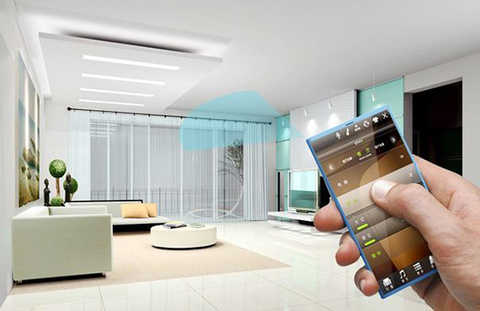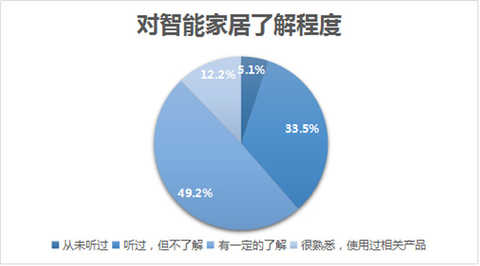Open the door no longer needs the key, the air conditioner can understand your heart, the kitchen provides you with the most intimate food... This is the beautiful blueprint that smart home has drawn for us. In recent years, various smart home enterprises and smart home products have emerged like spring bamboo shoots: smart door locks, smart routers, smart speakers, smart TVs, smart drying racks, smart curtains, and so on. The future of the smart home market is said to be over and over again, and people are advancing the future of smart homes.
The future of the smart home market is boundless
According to market research firm Statista's data report, the global smart home market in 2016 is close to 20 billion US dollars, of which the US market accounts for nearly 50% of the market share, while the Chinese market is 5.2 billion US dollars, accounting for 2.6%. Some people predict that with the further development of technology and the cultivation of consumption habits, smart home products will become more and more popular in the consumer market. It is estimated that by 2020, the market size of smart homes will exceed 50 billion US dollars.

Such an attractive market cake has attracted the participation of various enterprises, including Qualcomm, Intel and other established technology companies; Google, Apple, Microsoft, China's Tencent, Baidu, Ali and other Internet giants; also Haier, Midea, Samsung, and other home appliances Manufacturers; there are many entrepreneurs involved, and all players are actively involved, they want to taste the deliciousness of this cake.
Not only that, but the policy environment of the smart home industry is also good. Since 2009, central and local governments have continued to introduce policies to support the development of the smart home market. In 2012, the Ministry of Housing and Urban-Rural Development formulated the “Interim Administrative Measures for National Smart Cities Pilot†and the “National Smart City (District, Town) Pilot Indicator System (Trial)â€; in November 2013, the National Intelligent Building and Residential Area Digital Standards Technical Committee was officially released. The study of China's smart city standard system.
The “Twelfth Five-Year Plan†also clearly stated that smart home is one of the directions for cultivating the development of strategic emerging industries. The "Notice of the General Office of the State Council on Printing and Distributing Consumer Goods Standards and Quality Improvement Plan (2016-2020)" published in 2016 also pointed out that it is necessary to "improve the deep intelligence level of multi-variety and multi-brand home appliances and promote the rapid development of smart homes." The introduction of these policies has provided a strong policy guarantee for the development of smart homes.
The smart home market is still Wang Xietang Qianyan
However, although the data looks very optimistic, the facts do not seem to be so good. Today's smart homes present a series of strange phenomena such as lack of standards, prevalence of single products, multi-industry melee, and consumers not buying accounts. All this shows that smart homes are still the old Wang Xietang Qianyan, and the development of the smart home market will eventually be A time-consuming and laborious "prolonged war."
Market education has a long way to go
Although the development time of the smart home market is not short, and various domestic smart home platforms and products are frequently available, it has played a certain role in the popularization of smart homes. However, because the smart home market is mixed, the industry has been slow to tell consumers exactly what kind of tangible services smart homes can offer. This has made consumers' perceptions of smart homes in a relatively vague stage. According to the survey data, 33.5% of the respondents said that they have heard of smart home, but they don't understand it; 49.2% of them have a certain understanding; only 12.2% of respondents said they have used related products.

No experience, no intelligence
Consumers are not only aware of the level of smart home, but also the level of acceptance is not very high. We know that with the development of science and technology, the concept of intelligence has been deeply rooted in the hearts of the people. The life mentioned above in the clothes to open the mouth is a beautiful life that everyone is imagining. However, how good the ideal is, the reality is a lot of bones, these beautiful scenes may be really possible in the future, but it is difficult to achieve by the current smart home products.
At present, the good life in people's fantasy is just a propaganda concept that a business deliberately creates. However, after creating such a beautiful scene and raising the psychological expectations of consumers, it has not really solved the pain points of users in practical applications. It will even bring a lot of trouble.
According to a survey report by Ovid Consulting, 87.5% of users are dissatisfied with the current status of smart homes, indicating that they are completely inconsistent with expectations. The main reason is that the user experience is not good. Many users think that the smart home items that are popular in the market have little effect on improving the quality of life, but the price is much higher. Not only that, but many smart home products now have complex operations and limited functions. Many users often discard their products after they have been tasted.
Industry standards need to be unified
The single-product intelligent era in which single products are prevalent and each is king is the current status of smart homes and the biggest bottleneck facing the development of smart home market. The current smart home market cooperation system is very imperfect, there are boundaries between different brands, and cross-product cooperation is extremely Difficulties have seriously restricted the development of the smart home industry. For today's manufacturers, how to build a smart ecosystem and solve the problem of interoperability of smart home products is the primary problem, but the solution to this problem is not so easy.
If the smart home industry wants to integrate the industry chain and realize the interconnection of smart home products, it needs to form a standard and let everyone do it according to this standard. It is necessary to put everything in a unified platform, but who is this platform? It is the core and the most difficult problem to solve. After all, no one wants anyone to move their own cheese.
It is precisely because of the interests of enterprises that this has led to the current market situation of smart home products in the political and smart home market. We can find that the development of the entire smart home industry is not as rapid as imagined. At present, the industry not only lacks uniform standards, but also lacks an open foundation for establishing mature standards. Although some large enterprises have already realized that the IOT Alliance Front has been announced to accelerate the process of the development of the Internet of Things universal standards through information sharing, this is still far from enough. The unification of smart home Internet of things standards requires the collective participation of large and small enterprises. This is a long road.
Information security needs to be improved
In the Internet age, the more data users transmit, the more likely they are to be exposed, and the higher the probability of a security risk. The family contains a large amount of personal privacy information, so the cyber security issue of smart homes especially needs the attention of the industry. We know that smart home products such as smart sweeping robots and smart children's accompanying robots have been hacked and have security leaks. For consumers, once the privacy of personal information cannot be guaranteed, even if the experience of smart home is done well, it is useless, and the trust and security of consumers cannot be established. For enterprises, how to ensure the security of information has become the most urgent need after improving product experience and completing interconnection.
HC Security Network Summary
It is undeniable that smart homes bring infinite imagination to people's future life, and their development potential must not be underestimated. However, the ambitious future cannot erase the current status of the smart home industry at this stage. For the smart home industry, how to highly unify industry standards and coordinate development; grasping the real needs of users and improving user experience is a top priority. Only by really solving these problems, the "Wang Xietang Qianyan" of the smart home can truly "fly into the homes of ordinary people."
Editor in charge: Zhong Juanjuan
A5 Ribbed Manila Envelope,Skyline A5 Ribbed Envelope,Skyline A5 Ribbed Mailer,A5 Ribbed Brown Mailers
Sun Kee Envelopes Limited , https://www.sunkeeenvelope.com